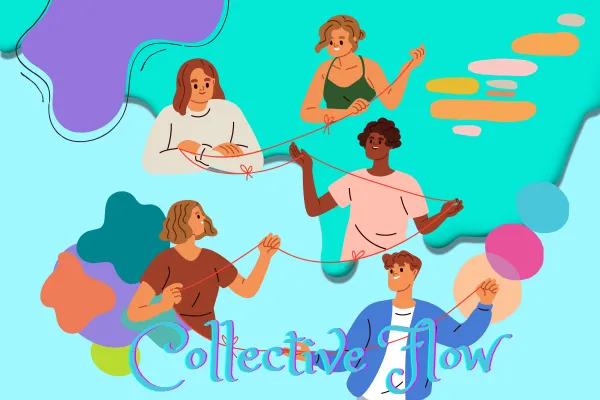
Discovering the Magic of Collective Flow: A Guide for Neurodivergent Folx
Today, we're diving into the concept of "Collective Flow," a powerful phenomenon that can bring immense joy, connection, and creativity into our lives. Whether you're new to this idea or looking to deepen your understanding, this blog post will guide you through what collective flow is, how it benefits neurodivergent folx, and how you can discover it in your own life.
In my own neurodivergent identity journey, this concept has come up for me quite often lately.
What is Collective Flow?
Collective flow occurs when a group of people enters a state of flow together, working seamlessly towards a common goal. Imagine the synergy in a well-coordinated sports team, a musical ensemble, or a collaborative art project where everyone is so in sync that it feels almost magical. This state of shared focus and engagement boosts individual performance and fosters a deep sense of community and belonging.
The Importance of Collective Flow for Neurodivergent Folx
For neurodivergent humans, finding a sense of belonging can sometimes be challenging due to the unique ways we interact with the world. Collective flow offers a pathway to connect deeply with others, creating an environment where everyone’s strengths are celebrated and understood. It’s about being part of a community where mutual respect and shared goals help each member thrive.
According to the article "Finding Belonging in Collective Flow," working towards a common goal in a safe and appreciative environment enhances one's ability to enter a flow state, which can be particularly beneficial for neurodivergent individuals. This collective experience is about individual achievement and creating a supportive network where everyone feels valued and understood.
How to Discover Collective Flow in Your Life
Join a Group with Shared Interests:
Find groups or communities that align with your passions, whether it's a book club, a crafting circle, a gaming group, or a volunteer organization. Shared interests create a natural foundation for collective flow.
Engage in Collaborative Projects:
Participate in projects that require teamwork and cooperation. This could be anything from a group art project to a community garden. The key is to work together towards a shared goal.
Create Safe and Inclusive Spaces:
Collective flow thrives in environments where everyone feels safe and appreciated. If you’re part of a group, foster a culture of respect and inclusion. Celebrate each member’s unique contributions and ensure everyone’s voice is heard.
Set Clear Goals and Roles:
For a group to achieve collective flow, it’s important to have clear objectives and defined roles. This helps everyone understand their part in the bigger picture and work more effectively together.
Communicate Openly and Often:
Effective communication is crucial. Share feedback, celebrate progress, and address challenges openly. This ongoing dialogue helps maintain the group’s momentum and keeps everyone engaged.
Embrace Monotropism:
Monotropism, the tendency to focus deeply on a single interest, can strengthen collective flow. When everyone brings their focused passion to the table, it enhances the collective energy and drives the group towards success.
Building Community Through Collective Flow
At FlowArt, we believe in the power of community and the incredible potential that collective flow can unlock. By fostering environments where neurodivergent individuals feel safe, valued, and connected, we can create spaces where everyone can shine. Whether through therapy, workshops, or community events, our goal is to build supportive networks that celebrate diversity and encourage collective growth. The FlowArt community will soon be growing into a place where you can connect with other neurodivergent folx who share similar interests and experiences (hint, we’ve got some special stuff planned for the next few months!).
Embrace Your Sparkle Together
Collective flow is about more than just achieving goals; it’s about building meaningful connections and creating a sense of belonging. As you explore ways to integrate collective flow into your life, remember that your unique contributions are what make these shared experiences so special. Together, we can create vibrant, inclusive communities where everyone’s sparkle is recognized and cherished.
Stay sparkly and connected!
References:
Edgar, H. (2023). Finding belonging in collective flow. MoreRealms. Retrieved from https://medium.com/@helenrealms/monotropism-collective-flow-bf057f287ef2
Csikszentmihalyi's Research on Flow:
Csikszentmihalyi, M. (1990). Flow: The psychology of optimal experience. Harper & Row.
Murray, D., Lesser, M., & Lawson, W. (2005). Attention, monotropism, and the diagnostic criteria for autism. Autism, 9(2), 139–156. https://doi.org/10.1177/1362361305051398
Additional References for Concepts:
Walker, N. (2021). Neuroqueer heresies: Notes on the neurodiversity paradigm, autistic empowerment, and postnormal possibilities. Autonomous Press.
Yunkaporta, T. (2020). Sand talk: How Indigenous thinking can save the world. HarperCollins.
Bettin, J. (2021). Nurturing ecologies of care. Retrieved from https://jornbettin.com/2020/10/12/nurturing-ecologies-of-care/
Wohlleben, P. (2017). The hidden life of trees: What they feel, how they communicate—Discoveries from a secret world. William Collins.
Simard, S. W., Perry, D. A., Jones, M. D., Myrold, D. D., Durall, D. M., & Molina, R. (1997). Net transfer of carbon between ectomycorrhizal tree species in the field. Nature, 388(6642), 579–582. https://doi.org/10.1038/41557
